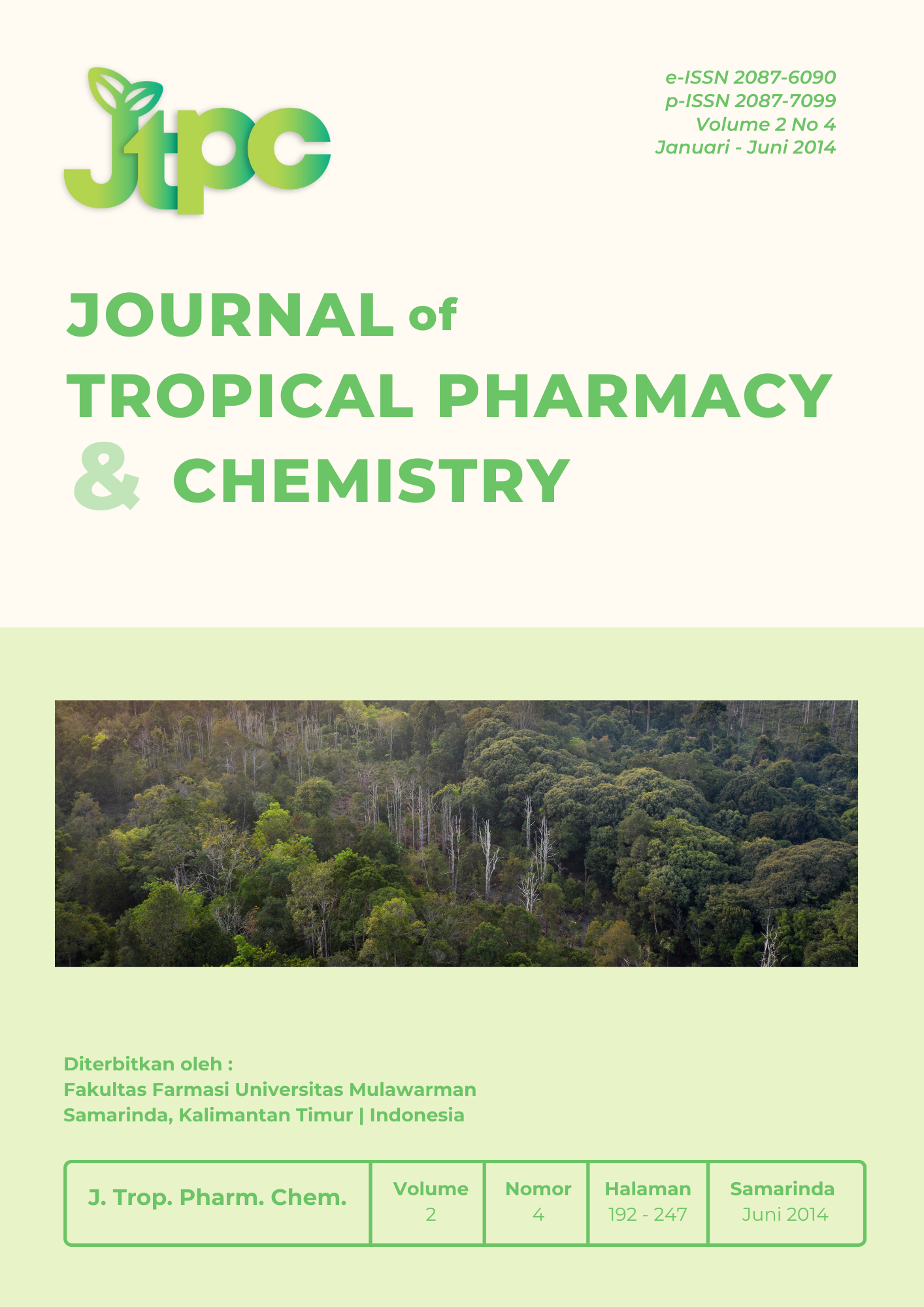Efektivitas Krim Ekstrak Metanol Batang Dan Daun Pacar Air (Impatiens balsamina L.) terhadap Bakteri Propionibacterium acnes
Keywords:
Antiacne, Impatiens balsamina L., stems and leaves extract, Propionibacterium acnesAbstract
Colonization of Propionibacterium acnes is one of factors that causes acne vulgaris. The present study was conducted to evaluate antiacne effect from cream of methanolic extract from stems and leaves of Impatiens balsamina L. towards Propionibacterium acnes, concentration that gives greatest antiacne effect and to evaluate physical and chemical properties of creams. Simplicia were extracted using soxhlet technique and methanol as solvent. Extract then formulated in cream in three variations of concentration as following 10%(F1), 15%(F2) and 20%(F3). The determination of antiacne effect was done using disc diffusion method. Evaluation of physical and chemical properties of those creams includes organoleptic examination, spreadability, adhesion and pH testing. Determination results showed the diameter of inhibition zone from F1, F2 and F3 were 8,37±2,205; 10,78±2,551; and 17,42±3,029 mm respectively. Analysis results showed that cream of F3 gave significantly greatest antiacne effect compared to F1 and F2 (p<0,05), and not significantly different to the positive control (p>0,05). The evaluation of creams showed that they had homogenous texture, nongreasy, easily washed, spreadability of 10,18±0,285 to 11,55±0,687 cm2, adhesion force of 33,299±2,821 to 60±0 minutes, and pH of 6,07±0,058 to 6,37±0,115, this showed that creams have good physical and chemical properties.
Downloads
References
1.Williams C, Layton AM. Treatment of acne: an update Expert. Rev Dermatol. 2006; 1(3): 429-438.
2.Rivera AE. Acne scarring: a review and current treatment modalities. JAm Acad Dermatol.2008; 59: 659–676.
3.Kurokawa I, Danby FW, Ju Q, Wang X, Xiang LF, Xia L, Chen W, Nagy I, Picardo M, Suh DH, Ganceviciene R, Schagen S, Tsatsou F, Zouboulis CC. New developments in our understanding of acne pathogenesis and treatment. Exp Dermatol.2009; 18: 821–832.
4.Olutunmbi Y, Paley K, English JC. Adolescent Female Acne: Etiology and Management. J Pediatr Adolesc Gynecol. 2008; 20(4): 171-176.
5.Gollnick H, Krautheim A. Topical treatment in acne: Current status and future aspects. Dermatol.2003; 206(1): 29- 36.
6.Ramos-e-Silva M, Coelho Carneiro SC. Acne Vulgaris: Review and Guidelines. Dermatol Nurs. 2009; 21(2): 63-68.
7.Auffret N. Acne today. What’s new?. Presse Med.2000; 29(19): 1091-1097.
8.Amit G, Ashawat M.S, Shailendra S, Swarnlata S. Phyrosome: a novel approach towards functional cosmetics.J Plant Sci. 2007; 26: 644-649.
9.Coates P, Vyakmam S, Eady EA, et al. Prevalence of antibiotic-resistant propionibacteria on the skin of acne patients: 10-year surveillance data and snapshot distribution study. Br J Dermatol. 2002; 146 (5): 840-848.
10.Ashawat MS, Amit G, Shailendra S, Swarnlata S. Role of highly specific and complex molecules in skin care. Int J Cancer Res. 2007; 3(4): 191-
195.
11.Wang YC, Li WY, Wu DC, Wang JJ, Wu CH, Liao JJ, Lin CK. In Vitro Activity of 2-methoxy-1,4-naphthoquinone and Stigmasta-7,22 diene-3β-ol
from Impatiens balsaminaL. against Multiple Antibiotic-Resistant Helicobacter pylori. Hindawi Publishing Corporation.2009. 1-8.
12.Buszello K, Muller BW. Emulsion as drug delivery systems. In Pharmaceutical Emulsions and Suspensions, Vol. 105, ed. Nielloud F and Marti-Mestres G. New York: Marcel Dekker, Inc. 2000. Hal 191.
13.Kuswahyuning R, Saifullah. Teknologi dan formulasi sediaan semipadat.
Yogyakarta: Laboratorium Teknologi Farmasi Fakultas Farmasi UGM. 2008. Hal 74.
14.Clinical and Laboratory Standards Institute. Performance standards for antimicrobial disk susceptibility tests. Approved standard M2-A9.CLSI, Wayne, PA. 2006.
15.Departemen Kesehatan Republik Indonesia. Farmakope Indonesia, edisi keempat. Jakarta: Direktorat Jenderal Pengawasan Obat dan Makanan. 1995.
16.Michael and Ash I. A Formulary of Cosmetic Preparation. Chemical Publishing Co., New York. 1977.
17.Vats A, Sharma P. Formulation and Evaluation of Topical Anti Acne Formulation of Coriander Oil. Inter. J. Pharm. Sci. Res. 2012; 2(3): 61-66.
18.Lim YH, Kim I.H, dan Seo JJ. In vitro activity of kaempferol isolated from the Impatiens balsamina alone and in combination with erythromycin or clindamycin against Propionibacterium acnes. J Microbiol. 2007; 45: 473-477.
19.Cowan MM. Plant Products as Antimicrobial Agents. Clin Microbiol Rev. 1999; 12 (4): 564-582.
20.Handali S, Hosseini H, Ameri A, Moghimipour E. Formulation and evaluation of an antibacterial cream from Oxalis corniculataaqueous extract. Jundishapur J Microbiol. 2011; 4(4): 255-260.
21.Nishihata T, et al. Percutaneous absorption of diclofenac in rats and humans: aqueous gel formulation. Int J Pharm Pharmacol. 1998; 50: 413.
22.Ueda CT, et al. Topical and Transdermal Drug Products. Pharmacopeial Forum. 2009; 35(3): 750-764.
23.Swastika A, Mufrod, Purwanto. Aktivitas antioksidan krim ekstrak sari tomat (Solanum lycopersicumL.). Trad. Med. J. 2013; 18(3): 132-140.
24.Lucero MJ, Vigo J, Leon MJ. A study of shear and compression deformations on hydrophylic gels of tretionin. Int J Pharm. 1994; 106: 125-133.
25.Asbill CS, Michniak BB. Percutaneous penetration enhancers: local versus transdermal activity. Pharmaceutical Science and Technology Today. 2000; 3(1): 36-41.
26.Saifullah STN. Teknologi dan Formulasi Sediaan Semipadat. Yogyakarta:
Laboratorium Teknologi Farmasi Fakultas Farmasi Universitas Gajah Mada. 2008. Hal 1-3.




